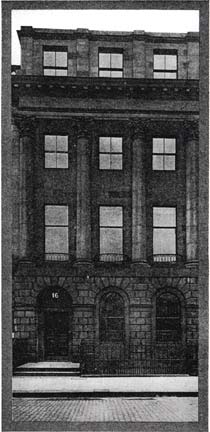|
EPS Premises 16 Royal Terrace |
|
Royal Scottish Society of Arts Building |
|
16 Royal Terrace ©
Reproduced by courtesy of
The Royal Scottish Society of Arts moved, along with its affiliated societies, including Edinburgh Photographic Society, to new premises at 16 Royal terrace in 1929. This photograph of the premises appeared in the RSSA Edinburgh Journal, January 1935 |
|
House |
||||||||||
|
EPS’s use of the premises at Royal Terrace were:-
|
||||||||||
|
Thank you to Ed Bain and his father, Langley P Bain for providing the details above. Langley was Curator of EPS, with responsibility for looking after EPS premises in the 1940s |
|
Garden |
|
The following year it was reported that: “The Secretary and Mr. A H MacLucas met a number of the Members at the Rooms on the afternoon of 5 July, and the company entered the Gardens of No. 16 Royal Terrace. It was discovered that the Society has one of the finest private gardens in the city. These gardens lie on the eastern slope of the Calton Hill and are nicely laid out, well kept, and secluded. In them Members will readily find suitable settings for portraiture and ciné work, free from the embarrassing attentions of the ubiquitous small boy. |
|
EPS Facilities |
|
In 1932, it was decided to replace one of the old-fashioned horizontal enlargers in the first-floor darkroom with a modern upright enlarger more suitable for the smaller negative sizes. Tubular electric heaters kept the darkroom area warm. The developing benches were over the sinks, but, due to complaints about the heating, a new bench, complete with recessed metal boxes fitted with 40watt bulbs and covered with a metal plate to provide warming, was installed onto one of the partition walls. Washing was carried out in another section of this area. From there one could enter a ‘dry room’, fitted with panchromatic lighting. This dark green light was much darker than other safety lighting, and it took quite some time to become accustomed to the light in order to find your box of plates. Of the rooms to the rear of this floor, a bathroom was converted into a locker room. A bedroom had until then been used for miscellaneous storage. One of the members, L. P. Bain (who was to be the society’s curator from March 1948 until 1954, and was involved with the early stages of setting up the later premises at 68 Great King Street), had previously suggested that this bedroom could be cleared and converted to a studio. This suggestion was approved, and he and a group of other volunteers carried out the necessary modifications. The new studio was in use by June 1947, with a charge of 1s 3d per hour being levied to cover the cost of lighting. A few months later, on the 22nd of October, he led a ‘Bring Your Camera’ Portraiture Evening (with models) in the Lecture Hall. |
|
Gracie Alison joined EPS in 1940, and became EPS Secretary from 1946 until 1985. In an article for the August 1988 EPS Bulletin, she looked back on the Society's life at 16 Royal Terrace and wrote: "In these days we shared premises with the RSSA. They owned the house in Royal Terrace and we were tenants. The EPS had the use of the lecture hall on Wednesdays and the floor above was entirely ours. The house was dark and gloomy, but if it was dreary it was nothing to the darkroom! Everything was very formal. No-one for a moment dreamt of using Christian names. It was always Mr This and Miss That. Meetings were very formal too. When I took over, they were held on only two Wednesdays of the month. One of these was always a travelogue. Some of us managed to get meetings every Wednesday and, in the main, abandon travelogues. This shocked some of the members deeply! One thing made our meetings unusual. Some sect or other held meetings in the room below the lecture hall and they sang all evening with enthusiasm - if not skill. It could be a bit disturbing. One thing which did not help the Club develop very well was that we had to be out of the premises by 10pm so that the caretaker could lock up." |
|
Premises for Sale |
|
Both RSSA and EPS had reducing membership, and financial problems during and after World War II. As a result, RSSA found it necessary to sell its premises at 16 Royal Terrace. EPS was given an opportunity to purchase the premises before they were put up for sale on the open market, but had no funds. The premises were finally sold in 1952, leaving EPS to search for alternative accommodation. |
